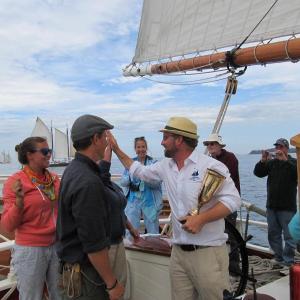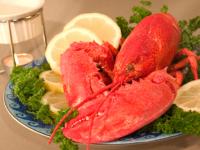Islesboro to Rockland: High drama, plenty of wind at the 2014 Great Schooner Race
 Noah Barnes, captain of the schooner Stephen Taber, with crew and passengers celebrating as they cross the finish line during the 2014 Great Schooner Race July 4. (Photo by Kay Stephens)
Noah Barnes, captain of the schooner Stephen Taber, with crew and passengers celebrating as they cross the finish line during the 2014 Great Schooner Race July 4. (Photo by Kay Stephens)
 Noah Barnes, captain of the schooner Stephen Taber, with crew and passengers celebrating as they cross the finish line during the 2014 Great Schooner Race July 4. (Photo by Kay Stephens)
Noah Barnes, captain of the schooner Stephen Taber, with crew and passengers celebrating as they cross the finish line during the 2014 Great Schooner Race July 4. (Photo by Kay Stephens)
ROCKLAND — "Oh crap, they're already underway," said one of the passengers on the Penobscot Ferry and Transport charter boat as we came into Islesboro's harbor.
We were there to meet up with the schooner Stephen Taber so we could sail back with them and follow the race. After nearly 90 minutes of motoring out from Rockland, we stood on the deck of the charter boat watching helplessly as the Stephen Taber, in full sail, cruised right on past.
The 2014 Great Schooner Race apparently had started early due to the impending gales that were closing in on Maine, and the participants had all agreed to get an early start.
Was that it? Were we going to miss it after all?
I held my disappointment in check as the captain of the charter boat turned us around. In the distance, we could see that the Stephen Taber had slowed down. That was the signal to get a move on—they were going to stop for us.
From the second I boarded the Stephen Taber to follow this year's Great Schooner Race, I knew this was not going to be an ordinary sail.
The hurricane weather coming up the East Coast was one factor. No one knew if a nasty squall was going to drop in on us mid-race. But so far, the sun was peeking out behind a wall of gray clouds and for the moment, there seemed like we'd get some good wind.
Each of the 16 vessels participating were staggered in order of class. For the non-boat nerds, basically it means that all the newest boats built in the 1980s are the fastest and lightest, so they got to stagger last in line. Next in line came the oldest schooners, built before and just after World War I. And in first position were the smaller day-sailors and other sailboats. The whole idea was to give everyone a fair advantage to reach the finish line.
The course this year was elongated to run from Islesboro to Rockland Harbor, then zoom back out again to the final point just beyond the Rockalnd Breakwater. Whoever crossed back across the Breakwater would be declared the winner.
It was 10:40 a.m.; the race was about to start. I couldn't tell what the mood was on all the other boats staggered about, but there was organized chaos on the Stephen Taber.
Capt. Noah Barnes is an easygoing guy with a great rapport with crew and passengers. His schooner was jammed full, not only with that week's passengers, but also some dedicated die-hard friends and race fans who annually hitch a ride for the race. Along with a couple of reporters on board, and Barnes’ wife, Jane, and 5-year-old Oscar, who had a lot of 5-year-old questions himself, there was a lot to keep in mind. But Barnes had this dialed in. He called out direction to the crew to trim the sails as he answered even more questions.
"On a race like this, it's all about who can stay in the breeze," he said. "See look at the French [Lewis R. French] over there. They've got these topsails that catch more air. Light air favors the French."
Light air favors the French. See, if you didn't have context, that could mean something completely different.
Behind the Stephen Taber, all of the schooners looked haphazard, zigzagging, not moving straight. To my untrained eye, this was actually progress.
"Everyone is trying to beat to windward," he said. "And the tide is coming into Penobscot Bay, so it's like everyone is trying to walk up the down escalator.”
Conventional racing wisdom, according to Barnes, is that no one wins by being brilliant. You win by not making mistakes. And one of the biggest mistakes he said he's made is heading toward an area where he thought the wind would be stronger and they sailed into a hole. They went off course, and lost the race that year.
"Sometimes you take a risk and it pays off,” he said. "Sometimes it doesn't.”
Carol Riman, from Randolph, Mass., has been on the Stephen Taber for race week for the past nine years. Last year, she needlepointed a belt for Barnes with the Stephen Taber depicted in the tiny schooners decorating the belt. Barnes wears it all week during race week.
"I had the chef sneak into his quarters and take a measurement of his belt size when I was working on it," she said. Suffice to say, she's one of the die-hard fans of the Great Schooner Race.
"I go home and my computer is full of race day shots,” she said. “I grew up on boats. I used to crew for my brother's friends. I'm very competitive and I think these races are awesome."
Giovany Hernandez from Los Angeles, Calif., is also a die-hard, returning passenger. "I liked it so much the first time we raced, I learned how to sail just watching them. Then I went back to LA and began sailing on a 27-foot sailboat."
As the Stephen Taber began to approach the Rockland Breakwater for the first of two passes in the race, the schooner seemed to wrestle with the wind. Within a span of seconds, as we approached the massive granite wall, things seemed to get dicey. Closing in 20-feet, 15-feet, then 12 feet, the Taber wasn't tacking fast enough to the left. My heart began to thump. Were we about to slam-bang into the Breakwater like the Titanic?
Just as my thoughts turned grim, the Taber luffed up and turned at the last second and we shaved by the Breakwater at 8 feet. Spectators on the Breakwater were covering their mouths, some visibly scared. Abrupt cheering ensued as we cleared.
Dramatic beginnings don't always warrant dramatic endings, but after five hours of tacking and sailing in the lead, Stephen Taber hit the very thing Barnes predicted would happen — a hole.
We were maybe less than a quarter mile from passing the final mark of the Rockland Breakwater for the second time when we just stopped. The sails waffled listlessly. In the distance, the Mary Day was gaining. They had more weight and were faster and more importantly...they had wind.
Things we're not looking good.
"Lower the Plain Jane!" Barnes called to his crew referring to the rowboat. They were going to row us in if we had to, which was totally within the rules. (The rules only precluded a vessel from using motorized power.) As the crew frantically loosened the ropes to lower the rowboat, Barnes called out again.
"Who's got a quarter?"
Someone gave him one, which he pitched it right over the port. "That's wind tax," someone observed. It was a sacrifice to Poseidon. Come on Gods, blow!
We were still not moving, but the wind was freshening.
Then, the next thing that happened, Barnes assured me was purely a figment of my embellishment.
Because I'm a schooner newbie (i.e. schoon-noob) at the last minute, when it looked like the Mary Day would overtake and surpass the Stephen Taber, out of nowhere the J. & E. Riggin tacked (which I was told it was their right to stand on) and dock-blocked the Mary Day. To me, it looked like a scene in one of those action movies where the reluctant buddy-cop makes his entrance at the last crucial moment to save the hero, as in when Han Solo closes in during the Death Star battle to back up Luke Skywalker.
To me, it looked like an 11th hour tactical move as the Mary Day found herself cut off in crucial seconds to take the lead. But again, that's just my movie magic imagination.
A fresh puff of air carried the Stephen Taber across the finish line and a small cannon fired as everyone covered their ears.
At 2:38 p.m. the 2014 Great Schooner Race declared a winner.
Check out a photo gallery of schooners in the race, courtesy of Capt. Daniel Bennett of Bufflehead. View the gallery here.
2014 Winners:
Flying Jib Class
1st: (Tie) Olad and Heritage
2nd: Winfield Lash
3rd: Summertime
Coaster Class
1st: Stephen Taber
2nd: Lewis R. French
3rd: Isaac H. Evans
Leeward Class
1st: Angelique
2nd: Heritage
3rd: J. & E. Riggin
Winward Class
1st: Mary Day
2nd: American Eagle
3rd: Heron
Overall
Stephen Taber
Kay Stephens can be reached at news@penbaypilot.com
Event Date
Address
United States






















